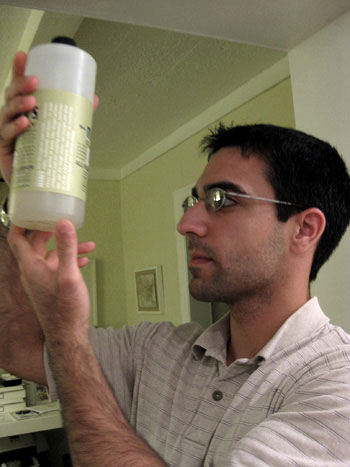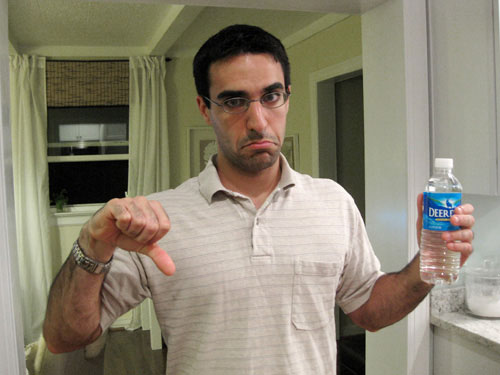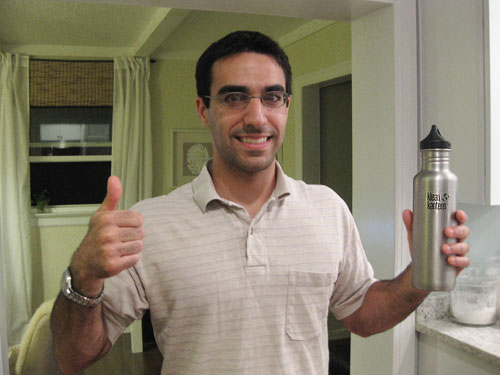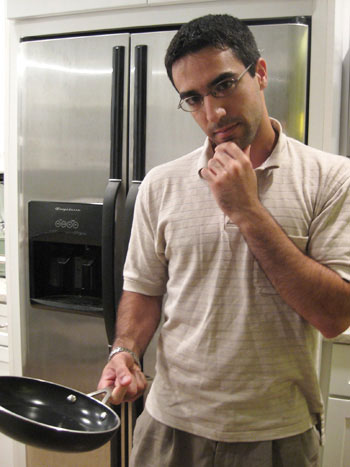Meet my über intelligent little brother* Dan.

Growing up I was always referred to as “the creative one” which was the family’s way of saying “not the prodigy” which was my brother’s territory. It wasn’t that I was dumb, I routinely made the honor roll and even got accepted early admission into a prestigious university art program in NYC (graduating with only 13 others in my major). But Dan was a bit hard to compete with in the brains department. In high school he took nine AP tests and got fives on all of them (I took one and got a 4). Then he got into Cornell and graduated with the highest GPA of his entire graduating class (a 4.21 if you’re wondering). Yup, out of all of the kids in Cornell’s College of Agriculture and Life Sciences, he was the Valedictorian. Yeah, he’s brainy.
Now he’s a graduate student at Columbia with a Master’s degree under his belt, steadily working his way up to his Doctorate in chemistry with a full scholarship from the National Science Foundation. Not only do they pay for his education but they actually pay him a stipend for rent and food- all in return for wearing a lab coat almost 24/7 and messing around with molecules and polymers all day. Sweet deal huh? Serious Einstein stuff going on.
Anyway, so when he recently visited us we got to chatting about… household chemicals (naturally). John and I love to live as purely as possible and stay away from the nasty stuff, so it was really eye opening to “mythbust” with my mad scientist sibling. What’s dangerous? What’s harmless? Here’s his almost-doctor take on the household habits and materials that’ll do you good or do you wrong.
What’s your take on BPA in plastic water bottles and other household plastics? Most evidence points to the fact that these chemicals are to be avoided, if not only for their effect on humans but also for their effect on the environment. It’s easy to use stainless steel or glass drinking containers to avoid BPA and I can’t imagine a time in the next hundred years that any evidence would point to dangers in glass or stainless steel, so those are a much safer bet.
The YHL takeaway: We love using stainless steel bottles like Klean Kanteen (we keep one at home, one at work, and one in the car for sipping without fear).


How about fireproofing chemicals that are used in many standard mattresses and pillows? They’re bad news. These objects that touch our bodies on a regular basis contain chemicals that, as they degrade, become “house dust” which you inhale. These chemicals are later found in your body, and even found in mothers’ breast milk, which is scary when you think about it.
The YHL takeaway: Snagging organic wool or cotton pillows without fireproofing chemicals (now available at Bed Bath & Beyond) is an easy upgrade, and the next time you’re in the market for a new mattress, grabbing something organic and chemical free will help you sleep easy (like our new latex one).
What about soaps and shampoos with sodium lauryl sulfate? Is that a chemical to be avoided as well? It’s hard to find things without that ingredient! I’m 99% sure that it’s a completely harmless ingredient. Sodium lauryl sulfate is essentially the product of your body’s metabolism of vegetable oils or fats, so it’s found in your own body when you digest fats- and because you can ingest quite high levels of it (and actually metabolize it) it stands to reason that there’s no danger to put it on your head or you skin.
The YHL takeaway: It’s nice to hear that not everything is indisputably bad for us, although we love Avalon Organics shampoo & conditioner (which are actually sodium lauryl sulfate free… just in case).
Teflon. Yea or Nay? This is a substance I would avoid if possible just to be safe. If you’re careful enough with your cookware (and never heat it to an extremely high temperature) it’s probably just fine. But the best way to be sure is to simply avoid it. Since the thermal degradation of Teflon and similar polymers would release toxic compounds into the air and your food, people have begun to move away from it, but this only occurs at temperatures that are higher than those required for cooking. If you feel that you really have to use it, avoid preheating your pans for unnecessarily long lengths of time, or using your Teflon pans for high-heat cooking. On a similar note, I would also avoid heating any plastics in the microwave (tupperware, saran wrap, etc) since the thermal degradation of these polymers can also occur, potentially releasing toxins into food. Again, as with teflon, normal cooking temperatures are probably okay, so if you feel you really have to microwave plastics try not to overheat them.
The YHL takeaway: We love our new Teflon-free Greenware pots and pans, made from eco-friendly materials that are chemical free (yet gloriously non-stick thanks to the Ceramica technology). And we swapped all of our tupperware out for glass containers (sold at Crate & Barrel and even Target) for safer microwave usage.

What about barbequeing meat? I’ve heard that it releases dangerous carcinogens into the grub. True? Yes, this method of cooking is probably not the safest. Essentially any act of cooking that chars the meat to the point of blackness is making polyaromatic hydrocarbons (aka PAHs) which are poorly metabolized by the body and may result in DNA damaging chemicals that could be carcinogenic. I haven’t heard concrete evidence linking cancer to burned meat so I can’t be sure, but from a chemistry standpoint those chemicals should be carcinogenic. Science points to avoiding them. One way to potentially avoid releasing these chemicals would be to marinate the meat beforehand, and keep it moist while cooking, since heating dry meat results in more charring.
The YHL takeaway: When you fire up the bbq, don’t forget to marinate your meat. And perhaps consider making it a once a week treat as opposed to an everyday effort.

What about phthalates? We’ve heard that they’re in a slew of products and they might not be best for humans or Mother Earth. Dish! I’ve only heard of these being used as plasticizers in bottles and containers, but in general, like BPAs, they appear very harmful to the environment and possibly harmful to humans as well (I’ve heard of studies in which these chemicals have been known to sterilize and even change the genders of fish and frogs).
The YHL takeaway: Say no thank you to phthalates by selecting a slew of products with a label that boasts that they’re phthalate free (we love companies like Tom’s Of Maine and Dr. Bronners for their dedication to avoiding ’em).
What’s something major that we should all stay away from? Anything that sets off multiple alarms in your mind when you picture people using these materials or products on a daily basis? In general from my random label-reading I would say that the most toxic ingredients you can find are usually in glues. For example the solvent for the glue used in model building is toluene, which is a potential carcinogen. Glues like Superglue also contain volatile organic compounds that are quite toxic until the glue dries, so if you are going to use these products using them in a well ventilated area is very important.
The YHL takeaway: Good to know. From this point on any glue-related craft project will be relegated to the great outdoors where it will remain until thoroughly dry.
Anything else we can glean from Almost-Dr. Dan? I think the vast majority of organic compounds that are dangerous have strong smells, so in general if you smell something that has a chemical odor it’s best to use it sparingly or with adequate ventilation.
The YHL takeaway: Make like Tucan Sam and follow your nose- and switch to something less stinky when you can. And if you’re seriously wondering what cyanocobalamin is, just ask your geeky brother (or mine). It’s a B vitamin by the way.
So there you have it. A slew of straight household-chemical-related answers from my brother, who spends 99% of his waking hours holding a test tube. For more ways to keep your home healthy, check out how we swapped out a few things in our home to live cleaner and greener in a snap. And feel free to pipe up with other ways to clean, bathe, and cook in safe and oh so smart ways!
*Yes, Daniel is my bona fide brother. Same mom and dad. He got the dark, brooding Italian hair and eyes from my mom (with a name like Diana Teresa DeCesare LaPadula she’s totally Italiano) and I got the fair skin and light eyes from my Austrian dad’s side of the family.

Leave a Reply